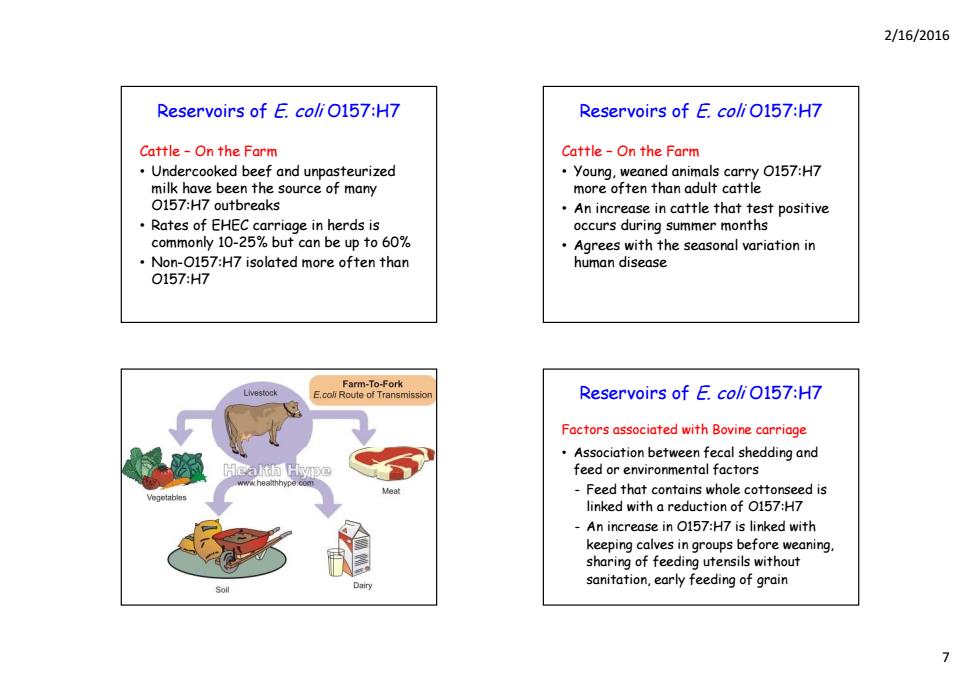
2/16/2016 Characteristics of EHEC O157:H7 Characteristics of EHEC 0157:H7 Antibiotic resistance Now,it is resistant to multiple antibiotics Inactivation by heat Non-0157:H7 strains are also resistant to Not more heat resistant than other many antibiotics used in human and animal pathogens medicine Fat in foods(hamburger meat)protects Antibiotic-resistant strains possess a growth 0157:H7 from heat advantage over other bacteria that colonize Critical Control Point to inactivate 0157:H7 the intestines of animals that are treated >heat food to an internal temperature of at therapeutically or sub-therapeutically. least 68.3C for several seconds Antibiotic-resistant strains may become the predominant strains during antibiotic therapy. Characteristics of EHEC 0157:H7 Reservoirs of E.coliO157:H7 Inactivation by irradiation Reservoir of infection:Any person,animal,plant, -Irradiation of food is approved to eliminate soil or substance in which an infectious agent normally lives and multiplies. foodborne pathogens Irradiation eliminates pathogens while -The reservoir typically harbors the maintaining the raw character of foods infectious agent without injury to itself and serves as a source from which other -Irradiation is approved to use on refrigerated individuals can be infected. and frozen raw ground beef The infectious agent primarily depends on the reservoir for its survival. Radura,symbol required on all food exposed to UV -The reservoir transmits the infectious radiation during processing substance to a human or another susceptible host. 6
2/16/2016 6 Characteristics of EHEC O157:H7 • Antibiotic resistance - Now, it is resistant to multiple antibiotics - Non-O157 H7 t i l i t t t O157:H7 strains are also resistant to many antibiotics used in human and animal medicine - Antibiotic-resistant strains possess a growth advantage over other bacteria that colonize the intestines of animals that are treated therapeutically or sub-therapeutically. - Antibiotic-resistant strains may become the predominant strains during antibiotic therapy. Characteristics of EHEC O157:H7 • Inactivation by heat - Not more heat resistant than other pathogens - Fat in foods (hamburger meat) protects O157:H7 from heat - Critical Control Point to inactivate O157:H7 heat food to an internal temperature of at least 68.3oC for several seconds Characteristics of EHEC O157:H7 • Inactivation by irradiation - Irradiation of food is approved to eliminate foodborne pathogens - Irradiation eliminates pathogens while maintaining the raw character of foods - Irradiation is approved to use on refrigerated and frozen raw ground beef Radura, a symbol required on all food exposed to UV radiation during processing Reservoirs of E. coli O157:H7 Reservoir of infection: Any person, animal, plant, soil or substance in which an infectious agent normally lives and multiplies normally lives and multiplies. - The reservoir typically harbors the infectious agent without injury to itself and serves as a source from which other individuals can be infected. - Th i f ti t i il d d The infectious agent primarily depends on the reservoir for its survival. - The reservoir transmits the infectious substance to a human or another susceptible host

2/16/2016 Reservoirs of E.coliO157:H7 Reservoirs of E.coli O157:H7 Cattle-On the Farm Cattle-On the Farm Undercooked beef and unpasteurized Young,weaned animals carry 0157:H7 milk have been the source of many more often than adult cattle O157:H7 outbreaks An increase in cattle that test positive Rates of EHEC carriage in herds is occurs during summer months commonly 10-25%but can be up to 60% Agrees with the seasonal variation in Non-0157:H7 isolated more often than human disease 0157:H7 Farm-To-Fork Livestock E.coli Route of Transmission Reservoirs of E.coli O157:H7 Factors associated with Bovine carriage Association between fecal shedding and feed or environmental factors Feed that contains whole cottonseed is linked with a reduction of 0157:H7 An increase in 0157:H7 is linked with keeping calves in groups before weaning. sharing of feeding utensils without Dairy sanitation,early feeding of grain
2/16/2016 7 Reservoirs of E. coli O157:H7 Cattle – On the Farm • Undercooked beef and unpasteurized milk have been the source of many O157:H7 outbreaks • Rates of EHEC carriage in herds is commonly 10-25% but can be up to 60% • Non-O157:H7 isolated more often than O157:H7 Reservoirs of E. coli O157:H7 Cattle – On the Farm • Young, weaned animals carry O157:H7 more often than adult cattle • An increase in cattle that test positive occurs during summer months • Agrees with the seasonal variation in human disease Reservoirs of E. coli O157:H7 Factors associated with Bovine carriage • A i i b f l h ddi d Association between fecal shedding and feed or environmental factors - Feed that contains whole cottonseed is linked with a reduction of O157:H7 - An increase in O157:H7 is linked with keeping calves in groups before weaning, sharing of feeding utensils without sanitation, early feeding of grain